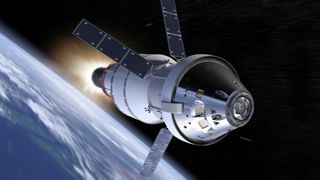Artemis 1 paves way for European tech and astronauts on the moon
Europe looks forward to joining lunar adventure.

NASA may be returning humans to the moon, but Europe is only getting its first shot through the Artemis partnership, which may see a European orbiting the moon in 2025 and a Europe-made lander touching down on Earth's natural companion later in the 2030s.
The European Space Agency (ESA) is overseeing the production of the Orion Service Modules, the technical support part of the Orion space capsule, which will take off for its debut flight to the moon and back next month.
"This is the first time that NASA relies on ESA for such a critical component for one of their flagship missions," Josef Aschbacher, ESA's director general said in a news conference on Tuesday (Aug. 23).
ESA, through lead contractor Airbus, currently has a contract to manufacture six Orion Service Modules, including the one mounted on top of the Space Launch System rocket that will shoot off toward the moon next week as part of the Artemis 1 test mission, and the one that is expected to return humans to the moon's orbit in 2024 as part of Artemis 2, which is already at NASA's Kennedy Space Center.
Related: Meet the Orion Service Module, the European-built brain of NASA's new spacecraft for moon trips
The service module, which provides propulsion, water, air regeneration, electricity and thermal control for the space capsule, is a spin-off from technology developed by ESA for its earlier ATV space station resupply vehicle. It marks the first occasion for the European space industry to build systems critical for the survival of human crew.
"The ESM is a big step forward because this is the first time that we are building a critical part of a human rated spacecraft," David Parker, ESA's director for human and robotic exploration said in the news conference. "This implies a level of performance safety testing unprecedented for your space industry. And so [the upcoming] test flight of Orion is exciting, challenging and nerve-wrecking."
Get the Space.com Newsletter
Breaking space news, the latest updates on rocket launches, skywatching events and more!
ESA has already secured three seats for European astronauts on future Artemis missions, with the trio of the lucky moon-explorers to be selected "soon," according to Aschbacher, from the current astronaut class of spacefarers that had already flown to the International Space Station. Italian Samantha Cristoforetti, currently at ISS with Crew-4, the U.K.'s Tim Peake, Germany's Matthias Maurer and Alexander Gerst, France's Thomas Pesquet, Denmark's Andreas Morgenstern and Italy's Luca Parmitano are all in the running.
According to Parker, a European might get to the moon's orbit as early as the 2025 mission, which will attempt a lunar landing, or later with the Artemis 4 or 5 missions.
ESA already committed to contribute hardware for the planned Gateway station in lunar orbit including a habitation module, a communication node and a refueling station. On top of that, the agency aspires to develop its own line of lunar cargo landers, called the Argonauts, for which it will seek funding from its member states later this year.
Follow Tereza Pultarova on Twitter @Tereza Pultarova Follow us on Twitter @Spacedotcom and on Facebook.
Join our Space Forums to keep talking space on the latest missions, night sky and more! And if you have a news tip, correction or comment, let us know at: community@space.com.

Tereza is a London-based science and technology journalist, aspiring fiction writer and amateur gymnast. Originally from Prague, the Czech Republic, she spent the first seven years of her career working as a reporter, script-writer and presenter for various TV programmes of the Czech Public Service Television. She later took a career break to pursue further education and added a Master's in Science from the International Space University, France, to her Bachelor's in Journalism and Master's in Cultural Anthropology from Prague's Charles University. She worked as a reporter at the Engineering and Technology magazine, freelanced for a range of publications including Live Science, Space.com, Professional Engineering, Via Satellite and Space News and served as a maternity cover science editor at the European Space Agency.
Most Popular


